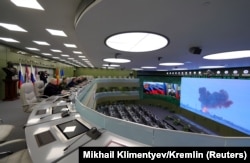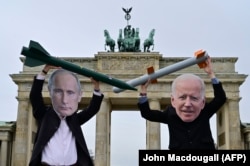Three days after launching the biggest invasion of another European nation since World War II, President Vladimir Putin put the world on further notice: In a televised meeting, he ordered Russia’s nuclear forces on “special combat readiness.”
In case anyone didn’t get the first message, Dmitry Kisleyov, a bombastic host on state-run TV, hammered it home hours later: "Now Russia's entire nuclear triad has been placed on special alert. Putin has warned [the world]. Don't try to frighten Russia.”
Western officials took heed – though privately they said they were less concerned with words than with actions. By the fourth week after the invasion, U.S. officials said there was no indication anything had changed for Russia’s silo-launched, submarine-launched, truck-launched, or air-launched nuclear weapons.
Still, threat or bluster, Putin’s nuclear saber-rattling in the middle of a hot war in Europe has renewed focus on how Russia plans for the “unthinkable” -- the use of the world’s largest nuclear arsenal -- and how the nuclear policies of other countries, chiefly the United States, might play into that.
“Few if any wars have been launched with as much nuclear posturing as Russia’s invasion of Ukraine,” said Olga Oliker, director of the Europe and Central Asia Program at the International Crisis Group, in an article published by the journal Foreign Affairs days after Putin’s announcement.
“I think the bottom line is that Russia's doctrine allows nuclear use in case of existential threat to the state,” she said in a follow-up message to RFE/RL. “Regime change is probably an existential threat to the state. But how useful nuclear weapons are for that isn't entirely clear. But there's a real danger there.”
“Putin’s threat is unprecedented in the post-Cold War era -- and unacceptable,” Daryl Kimball, head of the Washington-based Arms Control Association, said in a statement a day after Putin’s televised order. “There has been no instance in which a U.S. or a Russian leader has raised the alert level of their nuclear forces in the middle of a crisis in order to try to coerce the other side's behavior.”
Existential Danger
In 2020, Russia’s military planners released a new strategic document that offered more clarity on when Moscow could use nuclear weapons and what could justify it.
The document, titled Foundations Of State Policy Of The Russian Federation In The Field Of Nuclear Deterrence, stated that the use of nuclear weapons was an option only as a retaliatory measure against the use of nuclear weapons or other weapons of mass destruction -- or if “the very existence of the state is in jeopardy.”
Kremlin spokesman Dmitry Peskov reiterated that guideline in comments to CNN on March 22. Refusing to rule out the use of nuclear weapons, he emphasized that Russian policy allows it in the case of an “an existential threat for our country.”
On one level, that is highly unlikely: Moscow is on the offensive in Ukraine, after all, and neither Kyiv nor NATO is threatening any attack on Russia, let alone one so devastating.
For many analysts, though, a problem arises if the Kremlin and military commanders equate the existence of the Russian state with Putin’s rule.
And in Putin’s Russia -- where the parliament speaker has said there is no Russia without Putin, and senior officials offhandedly accuse the West of plotting the country’s demise -- that’s not so far-fetched.
On March 23, Dmitry Medvedev, the longtime Putin ally, former president, and current deputy head of Russia’s Security Council, suggested that escalating tensions could result in a nuclear disaster and alleged that Washington had engaged in a long-term plot to destroy Russia.
“The logic here is simple: if change of government is forced from the outside, the state is no longer sovereign,” said Nikolai Sokov, a senior fellow at the Vienna Center for Disarmament and Non-Proliferation and former Soviet and Russian diplomat who participated in major arms control negotiations.
“Which is why I believe that the most risky period will be after the fighting ends and the West will have to decide on what to do with Russia. If it goes too far -- the Iraq scenario -- then I do not rule out nuclear use,” he said.
“In the end, nuclear use does not have to be limited to military contingencies. It is possible to defeat a state by using nonmilitary tools, so (1) nuclear use is possible in peacetime and (2) policy should be very carefully calibrated,” he said in an e-mail.
Nuclear Doctrines
In 2018, President Donald Trump’s administration released a doctrine paper that spelled out both U.S. and Russian thinking about nuclear weapons use.
“Russian strategy and doctrine emphasize the potential coercive and military uses of nuclear weapons,” the paper said. Moscow “mistakenly assesses that the threat of nuclear escalation or actual first use of nuclear weapons would serve to ‘de-escalate’ a conflict on terms favorable to Russia. These mistaken perceptions increase the prospect for dangerous miscalculation and escalation.”
Where Ukraine is concerned, said one prominent Russian expert on nuclear issues, the conflict remains “strictly local.” That is, beyond supplying weapons and intelligence, NATO and the United States have gone out of their way to stay out.
They “are taking necessary measures to keep it that way, and Russia, although with rather explicit nuclear signaling, acknowledges that,” said the expert, who asked to speak anonymously due to growing concerns about government pressure on independent analysts and media.
Moreover, Russia hasn’t unleashed its full conventional arsenal: “The footage of Mariupol or Volnovakha is extremely depressing, but it gives a hint of what is possible, and on a much bigger scale.”
“Thus, there are no conditions for nuclear use,” he said.
A Russian nuclear strike would mean “we arrive to the uncharted waters of nuclear warfighting. And a nuclear war can never be won,” he said.
New START, Old START
Until the Russian invasion, arms control was one of a dwindling number of areas where United States and Russia could still talk to each other.
Even as relations spiraled downwards -- over Crimea, election meddling, Syria, the Kremlin’s poisoning of dissidents, and other issues -- Moscow and Washington maintained caps on their nuclear arsenals.
The Trump administration pulled out of the Intermediate-Range Nuclear Forces Treaty. But Trump did not pull out of New START, the sole remaining agreement limiting U.S. and Russian nuclear forces.
Trump’s successor, President Joe Biden, made it his administration’s first priority to agree with Russia to extend the treaty for five years, and the former Cold War foes did so just days after he took office in 2021.
For many Western experts, the Kremlin’s willingness to extend New START was an indication that Moscow was rational -- and pragmatic -- about its nuclear arsenal.
But that treaty does not include tactical, or nonstrategic, nuclear weapons -- less powerful arms that are designed not for flinging at distant cities atop long-distance missiles, but for local battlefield use. U.S. intelligence estimates Russia has more than 1,500 of them.
According to a Congressional Research Service report released this month, the United States has far fewer, around 230 in total. About 100 of those are deployed in Europe – mainly gravity bombs that are designed to be dropped from jets -- something Moscow has complained about for years.
“Russian statements, when combined with military exercises that seemed to simulate the use of nuclear weapons against NATO members, led many to believe that Russia might threaten to use its nonstrategic nuclear weapons to coerce or intimidate its neighbors,” the CRS report said.
For the moment, fears of instability or confusion within the Kremlin or in the strategic command structure that oversees operations of Russia’s nuclear weapons have been nonexistent, according to Western officials, who say the command-and-control procedures and chain of authority overseeing launch decisions is robust and competent and professional.
In recent days, U.S. and British officials have suggested publicly and privately that Putin was being misled by his closest advisers -- both about Russia’s capabilities in the run-up to the war and about ongoing operations.
This makes it even more unlikely that nuclear weapons would be used, said Kimberly Marten, an expert on Russian foreign and security policy at Barnard College, Columbia University, in New York.
It “implies that there is a screen of presumably rational officers, who don’t themselves want to experience nuclear war, who are serving as a filter between whatever emotional reactions Putin might have, and the battlefield,” she told RFE/RL in an e-mail.
"I wouldn’t go so far as to say that nuclear use isn’t going to happen, though," she said. "I remain concerned about a miscalculation or error that comes about through an inadvertent confrontation and escalation between Russian and NATO forces in a border area, for example."
The other calculation for the Kremlin, experts say, is whether limited use of a nuclear weapon or chemical weapons in Ukraine would result in exactly what it has adamantly warned against: NATO intervention in the conflict, prompted, for example, by a radioactive fallout drifting into alliance member states.
“I think Russia would use nuclear weapons to keep the war from becoming existential for it, and any war with NATO is existential,” Oliker said. “So there's a real risk if NATO states get directly involved.”
















